Gamtos Karunos : ‘Nature’s Crowns’
Lithuania has a longstanding tradition of creating seasonal natural crowns of flowers, grasses, tree branches, and linen. These crowns use only natural materials and are a wonderful way to connect with the seasons, the health of the bioregion, and your creative spark. Foraging and seeing what materials are abundant at a particular time of the year weaves you in with the lessons of that time in the Wheel of the Year. Although crowns can be made at any time, they are often created to honor and celebrate the pagan holidays of Ostara {Spring equinox}, and Beltane {peak of spring, beginning of summer}.
Beyond crowns you can also use these techniques to make wall decorations, garden stakes, and mobiles to hang from the ceiling or over a baby’s crib.
Giving credit to inspirational ancestors :
A big acknowledgment to Gintvilė Giedraitienė for her work in preserving and sharing this traditional Lithuanian folk craft. Her website, where you can purchase her creations and sign up for classes in Lithuania is { https://giedrazole.lt/ }. I give gratitude for her generosity and seek to expand access to this ecologically responsible art form through translating her work into English and adding additional techniques and styles.
Seasonal Themes :
The most proximal holiday in the wheel of the year was Beltane, which begins in the Northern Hemisphere at 15 degrees Taurus which is typically sundown April 30th, ending May 1st at sundown {although aš with the full and new moons the holiday aura lasts around 3 days}. This year, 15° degrees Taurus occurs on May 4, 2024 at 8:10 PM EDT and ends May 5, 2024 at 8:56 PM EDT. Beltane, or ‘bright goodly fire,’ marks the peak of spring & beginning of Summer. The sun’s power is celebrated symbolically through lighting fires, and traditionally, cattle and people walked through a gateway of two bonfires or jumped over a fire, cleansed themselves with smoke, or used the ashes to receive protection from this powerful element of alchemical transmutation. Beltane is a time to celebrate fertility, optimism, & the waxing power of the orb of day. The veils between the living and the spirit world are said to be thin, and nature spirits are thought to be especially active, & they appreciate offerings of art, nourishment, & tending to the environment.
Beltane is associated with the sun & symbolic representations of it ~ bonfires, smoke, ash, the colors yellow {representing energy, vitality, and the power of the sun} and red {passion, vitality, and the blossoming of life}. Secondary colors include green {growth, abundance, and the return of spring}, white {purity, new beginnings, and spiritual connection}, pink {love, romance, and affection}, and orange {enthusiasm, creativity, and joy}. Feasting. Love and romance and Heiros Gamos : the sacred marriage between the Goddess {May Queen, Beautiful Lady of the Earth, maiden goddess} and the God {Green Man, Big Deer, horned god of the greenwood}.
Meditation options while weaving your crown :
What materials call to you?
What energy are you adorning yourself with?
How do you wish to be seen?
What sensations do you wish to bring closer to you? The strength and suppleness of branches, the teasing tickle of grasses and oats?
How to make your crown :
- Gather your materials
In order of most difficult to least, you can :
Go all natural and make your foundational crown loop just with greenery, stems, small branches through braiding, coiling, or looping the stalks around each other.
Make a big raffia or fabric braid and stick stems into it.
Use a wire with thread, raffia, or ribbon looped around it that you use wire or florists tape to wrap around the stems and add as you go along, covering the wire or tape with the next bunch or flower.
Here at Wilbur, Greg Liston has identified the following plants as invasive and you can harvest them abundantly.
Wild Oat {Avena fatua}
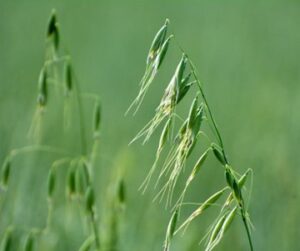
 Wilbur Oats photo by Greg Liston
Wilbur Oats photo by Greg Liston
Wild Mustard {Rhamphospermum arvense}

Wilbur Mustard photo by Greg Liston
Pepperweed {Lepidium latifolium}
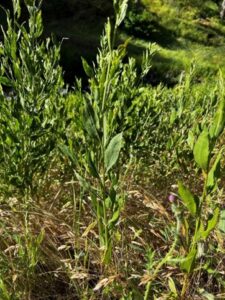
Wilbur Pepperweed photo by Greg Liston
Grey Pine {Pinus sabiniana}
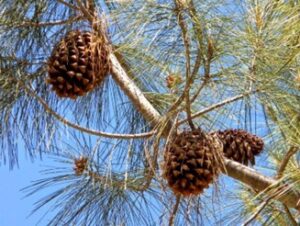
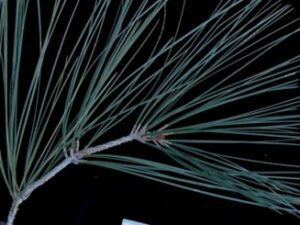

Wilbur Grey Pine photo by Greg Liston
{the smaller flexible stems of the Grey Pine make an ideal local crown base}
Sustainable Harvesting
In general, sustainable harvesting practice recommends that you collect only five percent of any individual patch of a given species within a maximum of 25 percent of an area. Choose to harvest plants that are common and regrow quickly (i.e. dandelions or yarrow) instead of plants that are less common and take a long time to grow. Don’t remove the entire plant from the ground, use sharp scissors to make a clean cut that can heal more readily. Avoid harvesting unless you have permission to do so.
2. Measure your head. Using a piece of thread or twine, measure the circumference of your head. Sit the thread at the angle that your wish your crown to be placed {eg. parallel to ground, at a diagonal high on your forehead and low at the back of the neck?}.
3. Make an initial crown core / foundation using the method of your choice. Below find the traditional Lithuanian grass method.
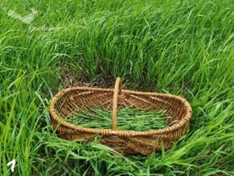

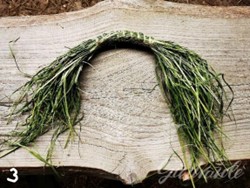




4. From here you can weave in the stems of flowers into the core foundation, in between the grass stalks and raffia pictured above or lay the blooms in bunches and wrap around with string or tie knots for each section. Alternatively you can add outwards or upwards grass offshoots using the following method. Some photo examples of directions and styles are provided for inspiration after the instructional section.

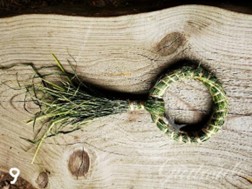

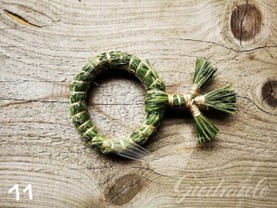

Alternative weaving methods :

Inspirational examples, patterns, designs from Giedrazole :
Building on the same crown techniques – inverted crown / baasket beginnings :
Mobile examples :
Wall Hangings, Bowls, Stakes :
Simpler Designs
Medium challenge designs
Complex designs
https://docs.google.com/document/d/1Kvw_yvBu3Ei4heQ29aT9p3_e8ndcvQPZ/edit?usp=sharing&ouid=105284053559582822051&rtpof=true&sd=true